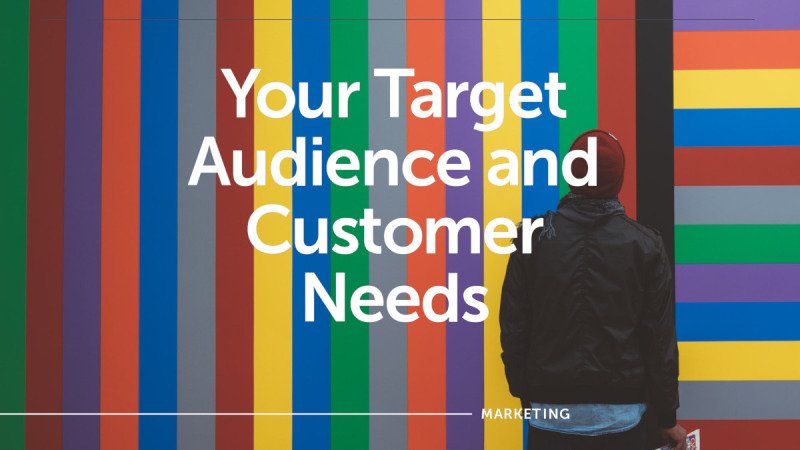Create a Winning Strategy: Target Needs
- Understand what need your product or service satisfies.
- What differentiates your offering from your competitors?
- Define the potential value of your business to customers.
- Feedback from your current team
- Existing analytics data
- Keyword Research
- Surveys and interviews
- Research on social media
- Competitor Research
- Lack of website traffic or leads.
- Ineffective social media strategies.
- Low conversion rates or sales.
- Poor search engine rankings.
- Inconsistent branding or messaging.
- Limited resources or ability in digital marketing.
Identifying your customer’s needs, and targeting the right customers is crucial for a business’s success – and a successful marketing strategy.
Knowing who you are trying to reach and their needs is the easiest way to help you position your brand and better craft your messaging.
You can grow your business by better understanding your target audience, their pain points, and their customer needs.
But how do you find your target audience and understand their needs or pain points?
This article discusses finding your business identity by knowing who you’re talking to.
Target Audience: Who Are You Talking To?
What is a target audience?
A target audience is the summary of the specific types of people, or audience groups, that are most likely to desire and benefit from your product or service.
You will define a target audience by demographics (age, gender, location) and psychographics (interests, values, behaviours).
Defining a target audience and their pain points enables you to create more effective strategies that resonate with your customers.
How do I find a Target Audience?
Finding a target audience is an essential aspect of any successful marketing strategy. You are getting to know who your customers are and what they look like collectively.
You can identify your target audience by researching demographics and psychographics.
Do this research and analysis in the following ways:
You will spend time collecting and analysing data from engagement and research in the following areas:
Demographics
Demographics is information about the demographic factors of your audience, including their age, gender, income, education level, marital status, and geographic location.
This information will help you create targeted messaging and content that appeals to these specific audiences.
Psychographics
Knowing your audience’s psychographics helps develop content and messaging that aligns with their attitudes and values.
Psychographics considers your audience’s psychological attributes, interests, values, attitudes, lifestyle and ideals.
Knowing your audience’s psychographics can help you create a message that resonates with your audience’s values and motivations.
Interests
Understanding audience interests can help you create inspiring content that aligns with their pursuits.
Interests include professional interests, passions, activities, hobbies, and other topics your audience is interested in.
Targeting audience passions and interests engages them on a deeper level.
Behaviours
How does your audience interact with your brand? What are their buying habits, preferred communication channels, and online behaviours?
Learning about your audience’s behaviours can help you create marketing strategies that reach them in their native environments. Communicating in audience ecosystems creates a positive brand experience as you’re part of the tribe.
E.g., Let’s say your audience is on LinkedIn; including Twitter branding in your posts might not hit entirely as well as LinkedIn-branded content on LinkedIn.
Needs
Discover the challenges that your audience is facing. Include your audience’s pain points and the problems they are trying to solve.
Understanding your audience’s needs helps you to develop a targeted solution that helps them resolve the issues they face.
They have a need; you solve the problem.
Profile Persona: How to Create Your Ideal Customer Profile
Once you’ve identified your primary audience, create buyer personas that represent your ideal customers.
These personas should include all the information you gathered about your target audience.
Including your target audience’s goals, challenges, and pain points is essential.
What is a Buyer Persona?
A solid understanding of your target audience is central to any successful marketing strategy.
A buyer persona builds on the target audience research we’ve just discussed.
Consider authoring a story where the lead character is a fictional person who encapsulates your ideal customer.
Our lead character, representing our buyers, has a detailed back story. Our buyer persona needs the same mindfulness.
The advantage of authoring the story of our ideal customer is that the buyer’s persona will help you see your target audience as real people with their own needs and preferences.
Developing a comprehensive and accurate customer persona can be done with the help of market research through surveys, interviews, and customer data analysis.
Uncover Your Audience’s Challenges with Market Research
Put yourself in the shoes of your customer. Think about who they are when creating your buyer persona or customer profile.
Define the problem your product solves and why customers need your product or service.
What is a Customer Pain Point?
A customer pain point is a specific problem or challenge that your target audience is experiencing in their daily lives or businesses.
The pain point is a source of frustration or inconvenience that motivates customers to seek solutions or alternatives to their current situation.
How do I Find Customer Pain Points?
Conducting market research will help gather data about your target audience and their pain points.
You can use feedback from your service and sales teams, keyword research, surveys, interviews, social listening, researching competitors, and other methods, to learn about customer needs, frustrations, and problems.
Specific pain points that businesses may experience include:
Ultimately by addressing your audience’s challenges and providing solutions that meet their needs, you can align your business with the customer and build trust and loyalty by solving their problems.
What are Customer Needs?
Customer needs are the wants and desires that customers have. Their needs are why they are searching for a product or service.
Your customer may not know what they need until they see it, therefor needs can be known or unknown.
Steve Jobs revolutionised the music industry with the introduction of the iPod. Before the iPod, people carried around CD players or portable cassette players, which were bulky and inconvenient.
Jobs recognised the need for a small, portable music player to hold thousands of songs and sync with a user’s computer.
He saw a need that customers didn’t even know they had, created a product that transformed the industry and changed the way we listen to music.
What Are Common Types of Customer Needs?
Customer needs can range from practical and functional to emotional and psychological.
For example, a customer might need a practical, dependable car with good fuel efficiency to get them to work every day. Another might want a vehicle that makes them feel safe or one that makes them feel special.
Understanding a customer’s practical and functional needs can help ensure the product or service is effective and valuable.
Address customer emotional and psychological requirements, creating a deeper connection and building loyalty.
How do you Identify Customer Needs?
Customer Needs Analysis: How to Find Customer Needs
Customer needs analysis is the process of gathering and analysing information about your target audience’s wants and needs.
This analysis typically includes demographic research, psychographic analysis, customer profiling, and buyer persona development.
Completing a customer needs analysis to help your business understand what your customers are looking for in a product or service.
Understand customer pain points, challenges, preferences, and expectations.
Meeting customer needs and desires will ultimately lead to higher customer satisfaction, loyalty, and revenue.
Rebranding to Deliver on Meeting Customers’ Needs
Market research is crucial for uncovering the pain points of your ideal customers.
Once armed with this knowledge, you can differentiate your business by creating tailored content, services, and products that provide real solutions to your buyer’s needs.
At this point, with a better understanding of your audience, it’s worth considering the repositioning of business and branding to make a real impact.
Why Does a Business Rebrand?
Companies rebrand as they may want to shift from being known for low prices to being known for quality.
Perhaps a brand repositions from being known as a local brand to a national or global brand.
Whatever the case, consider customer pain points and be known for the solution.
Rebranding around pain points requires a careful balance of addressing customer needs and keeping core values whilst upholding your brand’s identity.
You can reinvigorate and empower your business by rebranding around your customer’s needs.
Give your business a decisive competitive advantage that sets you apart.
Here are key reasons why rebranding might be worthwhile:
Staying Relevant
Rebranding can help a company stay current and appeal to a new audience amid changing market conditions, customer needs, and emerging technologies.
Greater Customer Loyalty
By identifying and addressing your customers’ pain points, you show them that you genuinely understand their needs and are committed to solving their problems.
Understanding your customer can lead to greater customer loyalty and retention.
Differentiation from Competitors
By focusing your branding and messaging around your customers’ pain points, you set your business apart from competitors who may not address these needs.
Focused branding and messaging can help you stand out in a crowded market and attract customers looking for specific solutions to their pain points.
Increased Sales and Revenues
You provide a valuable solution by creating products, services, and content that directly address your customer’s pain points.
Directly addressing customer pain points can increase your business’s sales and revenue.
Improved Brand Reputation
By rebranding to address customer pain points, you are proving your commitment to your customers and their needs.
Proving commitment to customer needs can help to improve your brand reputation.



